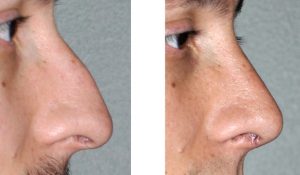Rhinoplasty is statistically seen as a top five male plastic surgery procedure. Most commonly these are younger men who desire changes in the shape of their nose or improvement in their breathing due to internal obstruction. While the technical aspects of a male rhinoplasty are not different than that of women, there are numerous psychological and treatment planning issues that need to be considered.
While the exact percentage is not precisely known, the majority of rhinoplasty surgeries done in men are in the younger age range. From teenager up to the early forties would capture nearly 90% of all male patients. For a variety of reasons, the male rhinoplasty has historically been considered a challenging and hard to please patient. This younger age range has much to do with that as one’s self-image and social integration is being formed or challenged. While this is the same age range that women have the procedure, they are not nearly as difficult to manage. Men tend to be less patient, more critical and quickly assertive when things are not going as they envision it to be. Men are more likely to appear with nose drawings, analysis and pictures of model noses they would like to have. To say that some men may not be realistic in their expectations is not an unfair assessment. Thorough preoperative discussions with computer imaging is important. It is just, if not more important, to review what is not possible than what can be achieved.
The male rhinoplasty patient frequently wants or considers other structural facial procedures. While the nose can be the only facial structure they are interested in changing, frequently the younger man is looking for overall facial restructuring as well. Whether it is a stronger chin or jawline enhancement or higher more prominent cheek bones, many men are striving for a more defined angular or chiseled face. When considering numerous facial structural changes, it is imperative that presurgical imaging is done. When the number of facial structural changes exceeds two or more, it can be difficult to hit the their ideal aesthetic goals. Men need to be aware of the high revision rate due to their desire for aesthetic adjustments of one or more of the altered facial areas.


The challenges of a male rhinoplasty is in the before and after management, not the technical execution of the procedure in most cases. Discussing realistic expectations, having a tolerance of a longer than expected recovery, and understanding that the need for revisional surgery is common, will help the male patient have a satisfactory rhinoplasty outcome and experience.
Dr. Barry Eppley
Indianapolis, Indiana


